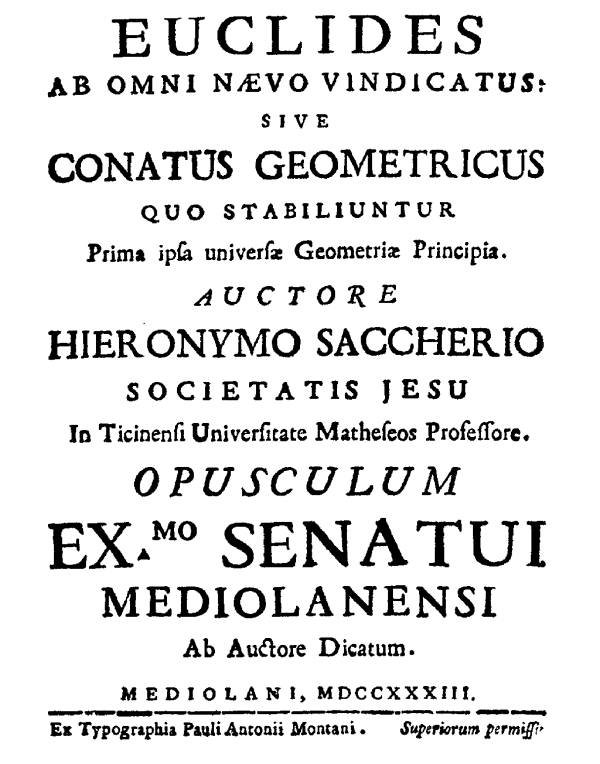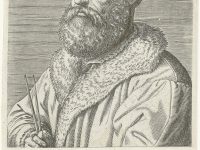
The frontispiece of Giovanni Saccheri’s “Euclides ab omni nævo vindicatus” (1733).
On September 5, 1667, Italian Jesuit priest, scholastic philosopher, and mathematician Giovanni Girolamo Saccheri was born. He is primarily known today for his last publication, Euclide Ab Omni Naevo Vindicatus (Euclid Freed of Every Flaw, 1733), now considered the second work in non-Euclidean geometry.
First Contact with Euclid’s Elements
Saccheri was born in Sanremo to his father Giovanni Felice Saccheri, a lawyer and notary.[6] As a child Saccheri ‘was notably precocious’.[1] He entered the Jesuit order in 1685, and from 1687 onwards he began teaching at the College as well as studying philosophy and theology. In 1690 the Superiors of the Company of Jesus sent Saccheri to the Collegio di Brera in Milan, where he was encouraged to take up mathematics by one of his teachers Tommaso Ceva who suggested that he read Christopher Clavius‘s edition of Euclid’s Elements.[4] It was through the influence of Giovanni Ceva that Saccheri published his first mathematical work Quaesita geometrica (1693), in which he solved many problems in elementary geometry. It was not a particularly significant work but showed that Saccheri was becoming deeply involved in thinking about Euclidean geometry.
A Jesuit and Mathematician
Saccheri was ordained a priest in March 1694 at Como and then later in the year he was sent by the Superiors of the Jesuit Order to teach philosophy at the Jesuit College in Turin, which led to the publication of Logica demonstrativa (1697), which covered the course on logic that he had been teaching in Turin. In 1697, Saccheri was sent to the Jesuit College of Pavia to teach philosophy and theology, where he stayed until his death, but he also held the chair of mathematics at the University of Pavia from 1699 until his death.
Euclid Freed of Every Flaw
However, Saccheri today is primarily remembered for his last publication Euclides ab Omni Naevo Vindicatus (Euclid Freed of Every Flaw, 1733), which was published shortly before his death and is now considered the second work in non-Euclidean geometry, although he did not see it as such, rather an attempt to prove the parallel postulate of Euclid. Interestingly, it remained in obscurity until its rediscovery by Eugenio Beltrami 150 years later.[2] Many of Saccheri’s ideas have a precedent in the 11th Century Persian polymath Omar Khayyám‘s Discussion of Difficulties in Euclid, a fact ignored in most Western sources until recently.[7] It is unclear whether Saccheri had access to this work in translation, or developed his ideas independently.
Euclid’s Parallel Postulate…
The intent of Saccheri’s work was ostensibly to establish the validity of Euclid by means of a reductio ad absurdum proof of any alternative to Euclid’s parallel postulate. To do this he assumed that the parallel postulate was false, and attempted to derive a contradiction. Since Euclid’s postulate is equivalent to the statement that the sum of the internal angles of a triangle is 180°, he considered both the hypothesis that the angles add up to more or less than 180°. The first led to the conclusion that straight lines are finite, contradicting Euclid’s second postulate. So, Saccheri correctly rejected it. However, today this principle is accepted as the basis of elliptic geometry, where both the second and fifth postulates are rejected.
…and Reductio ad Absurdum
The second possibility turned out to be harder to refute. In fact he was unable to derive a logical contradiction and instead derived many non-intuitive results. He finally concluded that: “the hypothesis of the acute angle is absolutely false; because it is repugnant to the nature of straight lines“. Today, his results are theorems of hyperbolic geometry. There is some minor argument on whether Saccheri really meant that, as he published his work in the final year of his life, came extremely close to discovering non-Euclidean geometry and was a logician. Some believe Saccheri concluded as he did only to avoid the criticism that might come from seemingly-illogical aspects of hyperbolic geometry.
Gierolamo Saccheri died in Milan on 25 October 1733. It should take 170 years until the significance of the work was realized.[1]
Non-Euclidean Geometry [Topics in the History of Mathematics] [10]
References and Further Reading:
- [1] O’Connor, John J.; Robertson, Edmund F., “Giovanni Gierolamo Saccheri“, MacTutor History of Mathematics archive, University of St Andrews.
- [2] Eugenio Beltrami and Non-Euclidian Geometry, SciHi blog, Nov 16, 2014.
- [3] Nikolai Lobachevsky – The Copernicus of Geometry, SciHi blog, Feb, 24, 2015.
- [4] Euclid – the Father of Geometry, SciHi blog, Jan 30, 2015.
- [5] Works by or about Girolamo Saccheria at German National Library
- [6] Saccheri, Giovanni Gierolamo, at The Galileo Project, Rice University
- [7] Omar Khayyam – Mathematics and Poetry, SciHi Blog
- [8] Girolamo Saccheri, Euclides Vindicatus (1733), edited and translated by G. B. Halsted, 1st ed. (1920)
- [9] Gierolamo Saccheri at Wikidata
- [10] Non-Euclidean Geometry [Topics in the History of Mathematics], via marshare @ youtube
- [11] Timeline of Italian 17th century mathematicians, via Wikidata and DBpedia





